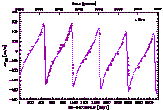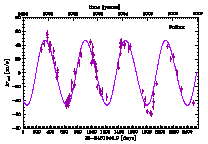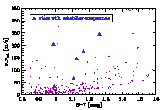Exoplanets around Giant Stars |
Lick
From 1999 to 2012 we have regularly monitored the radial velocities of a sample of 373 G and K giant stars at Lick Observatory, using the 60cm CAT Telescope and the Hamilton High Resolution Echelle Spectrograph in conjunction with an iodine cell. With this setup, we reach a relative radial velocity accuracy between 5 and 8 m/s for most of our giant stars.
 The giants have been selected from the Hipparcos Catalogue for brightness (brighter than
6 mag) and for mass so that we can to study the effect of primary mass on substellar
companion properties.
The giants have been selected from the Hipparcos Catalogue for brightness (brighter than
6 mag) and for mass so that we can to study the effect of primary mass on substellar
companion properties.
We continue to search for planets in this giant star sample; many have been found already (see below), but we continue to find planets with longer periods, which are particularly interesting. We also have many systems which we classify as 'planet candidates'; their radial velocity curves are clearly periodic, but we need to rule out other alternative explanations for the periodic radial velocities. In support of this effort we have taken radial velocities in the infrared with CRIRES, and more recently with Carmenes. Matching radial velocities in the optical and in the infrared make alternative explanations much less likely.
Furthermore, we want to understand the differences in the planet properties in our sample as compared to those of main-sequence samples, which might have been caused by stellar evolution.
There are a number of multiple planetary systems as well as planets in stellar binary systems in our sample, which we model dynamically. The effects of dynamical interactions between the components often become visible in the data only after decades of observations, so there is a real benefit in continued monitoring of those systems.
We intend to start monitoring all stars from the Lick sample with the Waltz Spectrograph soon!
Kepler
 We have followed up a few giant stars which show signs of a transiting exoplanet
in the Kepler data. We have used the CAFE spectrograph at
Calar Alto (Spain),
the FIES spectrograph at the
NOT Telescope as well as the HARPS-N
spectrograph at the
TNG Telescope on La Palma (Spain).
It is harder to detect a transiting planet around a giant star than around a main-sequence
star, because the giant star is so much bigger that the affected part of the stellar disk
being occulted is hard to notice. However, the few transiting planets around giant stars
discovered by Kepler all turn out to be in very interesting configurations.
See e.g. the
press release
about Kepler 432b!
We have followed up a few giant stars which show signs of a transiting exoplanet
in the Kepler data. We have used the CAFE spectrograph at
Calar Alto (Spain),
the FIES spectrograph at the
NOT Telescope as well as the HARPS-N
spectrograph at the
TNG Telescope on La Palma (Spain).
It is harder to detect a transiting planet around a giant star than around a main-sequence
star, because the giant star is so much bigger that the affected part of the stellar disk
being occulted is hard to notice. However, the few transiting planets around giant stars
discovered by Kepler all turn out to be in very interesting configurations.
See e.g. the
press release
about Kepler 432b!
Planet Occurrence Rate
We have instigated the planet occurrence rate as a function of stellar metallicity and stellar mass in our Lick sample. Interestingly, we find about the same planet-metallicity relation as is known to exit for giant planets around main-sequence stars. The planet occurrence rate further seems to rise until a stellar mass of about 1.9 M☉, but then decrease again for yet more massive stars. None of the 113 stars more massive than 2.7 M☉ in our sample hosts a planet.
Early Discoveries
iota Draconis
The first substellar companion known around a giant star was announced by our group
in 2001 and published in
2002.
 The companion orbits the K giant iota Draconis in an eccentric orbit with
a period of about 1.5 years and has a minimum mass of 8.8 Jupiter masses; depending
on the unknown inclination, it might be either a massive planet or a lightweight
brown dwarf. Due to the non-detection of the companion in the Hipparcos Catalogue, the
object must be of substellar nature.
The companion orbits the K giant iota Draconis in an eccentric orbit with
a period of about 1.5 years and has a minimum mass of 8.8 Jupiter masses; depending
on the unknown inclination, it might be either a massive planet or a lightweight
brown dwarf. Due to the non-detection of the companion in the Hipparcos Catalogue, the
object must be of substellar nature.
The original press release and some updated information about the orbital parameters of iota Draconis b can be found on our iota Dra webpage.
Pollux
 It has long been speculated that Pollux harbors a planet. Our radial velocities for that star,
along with many older ones, helped to confirm that this hypothesis is correct. The period
is about 590 days, and the minimum mass of the companion is about 1.9 Jupiter masses; it is
thus most likely a planet and not a brown dwarf, although the inclination of the orbit is
unknown. The planet orbits in an almost circular orbit.
It has long been speculated that Pollux harbors a planet. Our radial velocities for that star,
along with many older ones, helped to confirm that this hypothesis is correct. The period
is about 590 days, and the minimum mass of the companion is about 1.9 Jupiter masses; it is
thus most likely a planet and not a brown dwarf, although the inclination of the orbit is
unknown. The planet orbits in an almost circular orbit.
Radial Velocities of Giant Stars in General
 Our group has also published some papers characterizing the radial velocities of giant stars
in a statistical sense. We demonstrated for example that there is a trend for the redder
K giants to display larger intrinsic radial velocity jitter than the early K giants or
late G giants. Also, we showed that for the early K giants, the typical intrinsic radial velocity
jitter is of order 20 m/s, allowing for the detection of the more massive planetary companions
around these stars.
Our group has also published some papers characterizing the radial velocities of giant stars
in a statistical sense. We demonstrated for example that there is a trend for the redder
K giants to display larger intrinsic radial velocity jitter than the early K giants or
late G giants. Also, we showed that for the early K giants, the typical intrinsic radial velocity
jitter is of order 20 m/s, allowing for the detection of the more massive planetary companions
around these stars.
See the publication page of our group for more details.
At the moment, we work on validating more candidate planets, dynamical analysis of multiple planetary systems, and on the planet occurrence rate as a function of stellar mass. We also investigate the effect of stellar evolution an planetary orbits. Stay tuned!